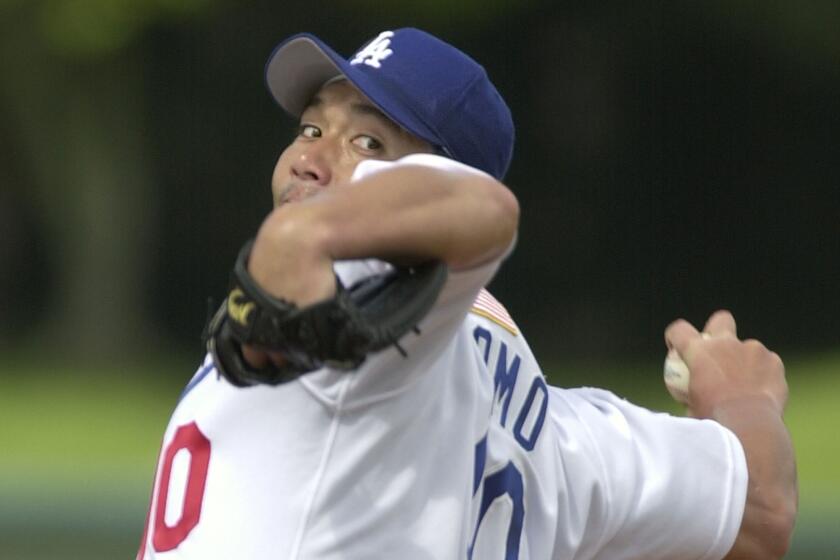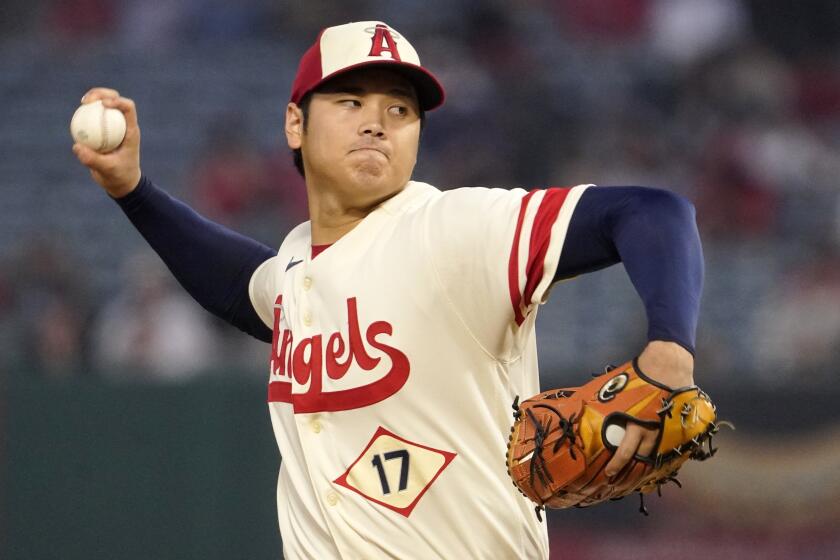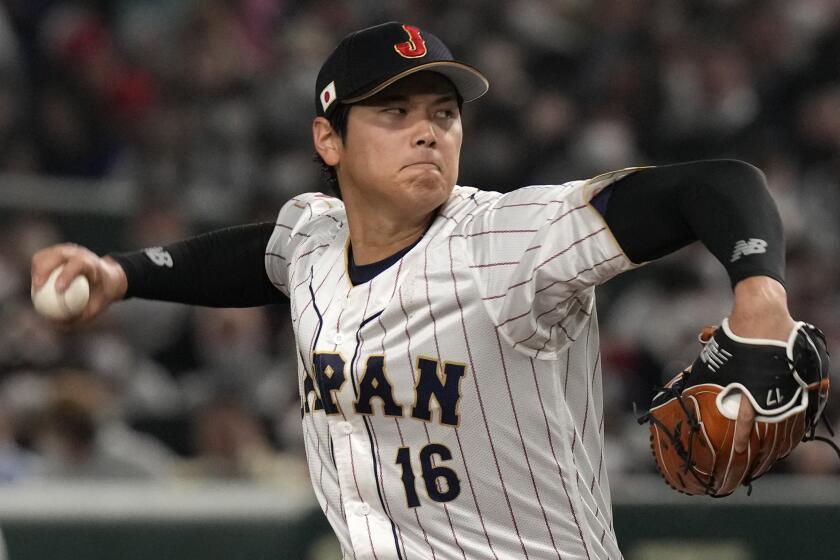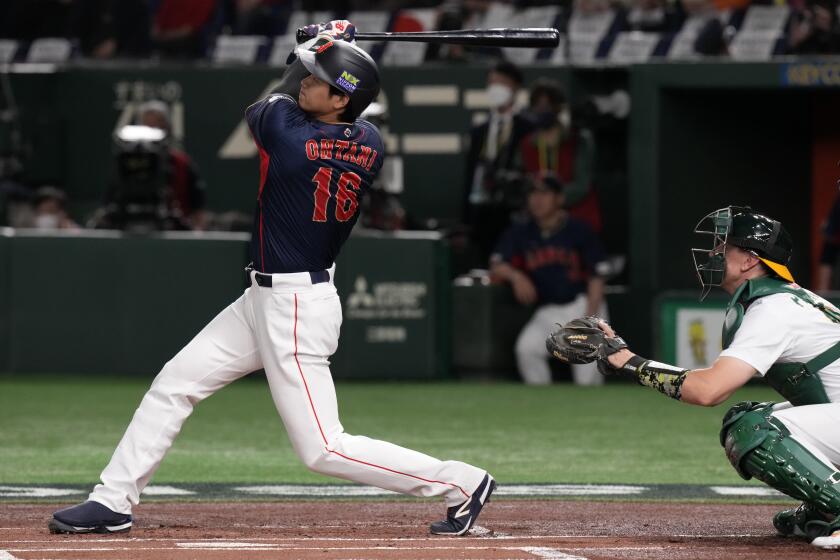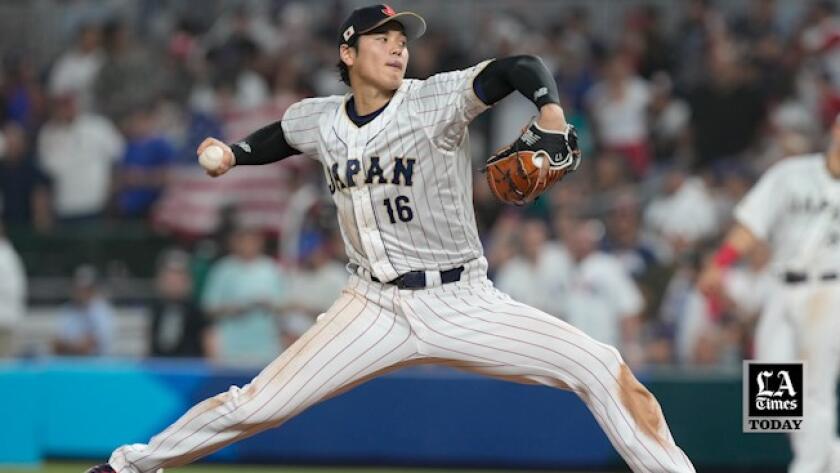‘He has changed my life completely.’ What it’s like covering Shohei Ohtani
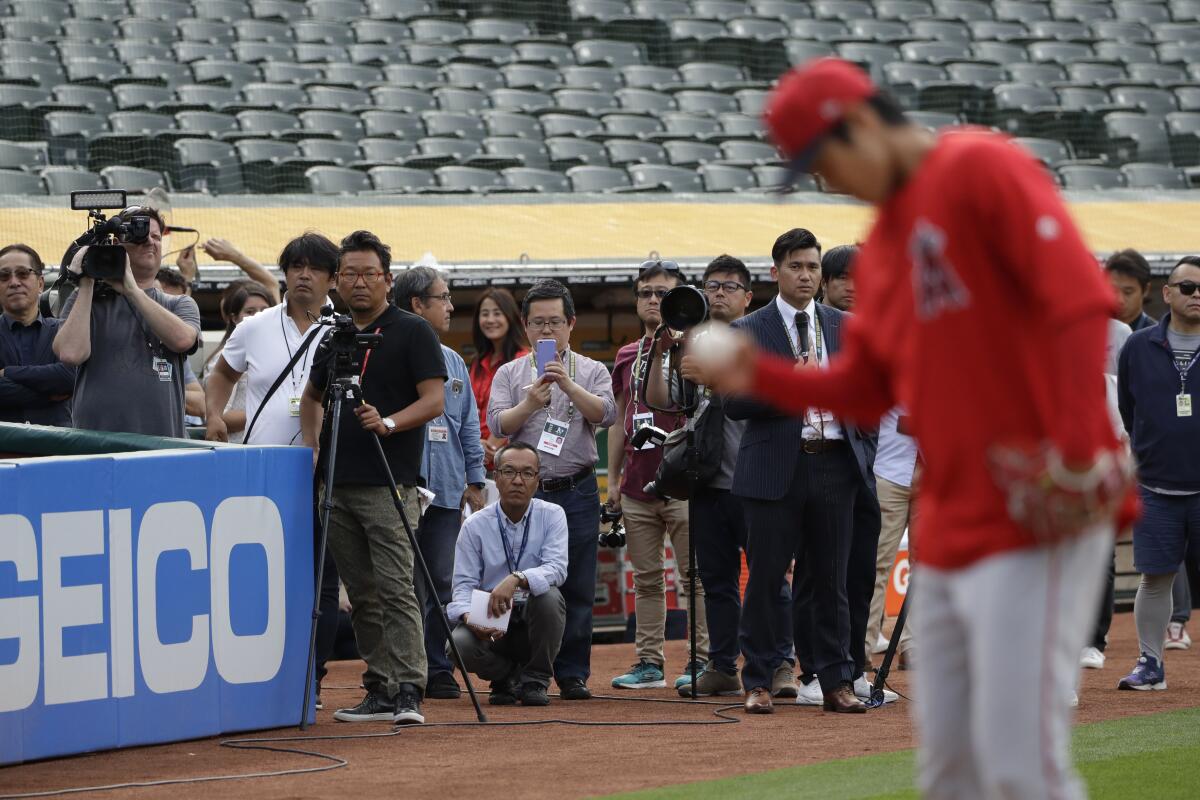
- Share via
Naoyuki Yanagihara’s life mostly revolves around Shohei Ohtani.
If he posts on his Instagram page, Yanagihara writes about it. Everywhere Ohtani travels for baseball, Yanagihara follows. During spring training, if Ohtani isn’t at the Tempe, Ariz., facility yet, he waits for his car to pull up.
Yanagihara, who writes for Sports Nippon, an all-sports daily Japanese newspaper, has been covering Ohtani since 2013, his rookie year with the Hokkaido Nippon-Ham Fighters.
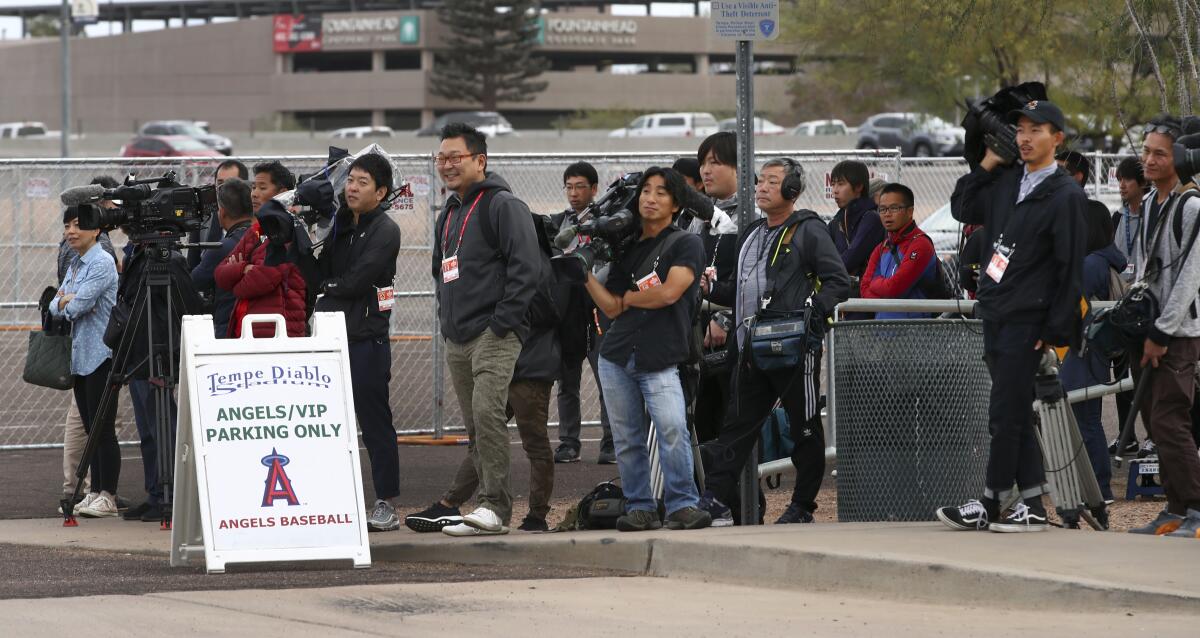
Yanagihara does not live in the U.S. His home is in Tokyo, where he lives with his wife and 9-month old baby for half the year, spending the other half living out of hotels in the U.S.
“Every day, I make a phone call, a video call to my wife,” he said. “Around 7 or 8 p.m., so it’s morning over in Japan. I always struggle with jet lag.”
This is the life of a Japanese sportswriter, one assigned to cover the country’s biggest star playing in Major League Baseball. He’s one of dozens who, since Ohtani signed with the Angels in December 2017, has been to just about every game and every day of spring training that Ohtani is at.
And he’ll likely be one of the dozens who, depending on what happens this season with the Angels, could be following Ohtani to another city should he sign elsewhere in free agency or be moved before the end of the season.
“He has changed my life completely,” he said. “I have to follow him almost every day, every year.”
Ohtani is more popular to Japanese media and culture than Hideo Nomo, who spent nearly seven of his 12 MLB seasons with the Dodgers. And Ohtani’s even bigger than Ichiro Suzuki, who spent the majority of his 18-plus seasons in the big leagues with the Seattle Mariners.
The Dodgers’ Hideo Nomo, with a quirky windup and devastating forkball, pioneered Japanese players coming to the U.S. by quickly becoming an All-Star.
Ohtani is not just the biggest baseball star the country has had — his global reach already makes that point clear.
“He’s a Japanese idol, an icon,” Yanagihara said.
“It’s very important for us to also take videos and take photos [of him] because he’s so handsome and he’s cool and he’s just like a pop star,” added Taro Abe, who has been on the Ohtani beat for the last two years for another daily Japanese newspaper, the Chunichi Shimbun.
Does that make him the Beyoncé of Japan? Abe, and another writer, Natsuko Aoike, who writes for Tokyo Sports, a Japanese tabloid, made skeptical faces at the question.
Maybe Ohtani, in Japan, is even more popular than that.
In Japan, covering baseball players is different than it is in the United States. Media members are allowed everywhere except the clubhouse. Relationships with the players are built outside of the stadiums. If a journalist needs to reach a player, they will wait for them, for example, in the lobby that leads to the player’s parking lot. Getting to know a player can involve the writers going to dinner with that player or their families.
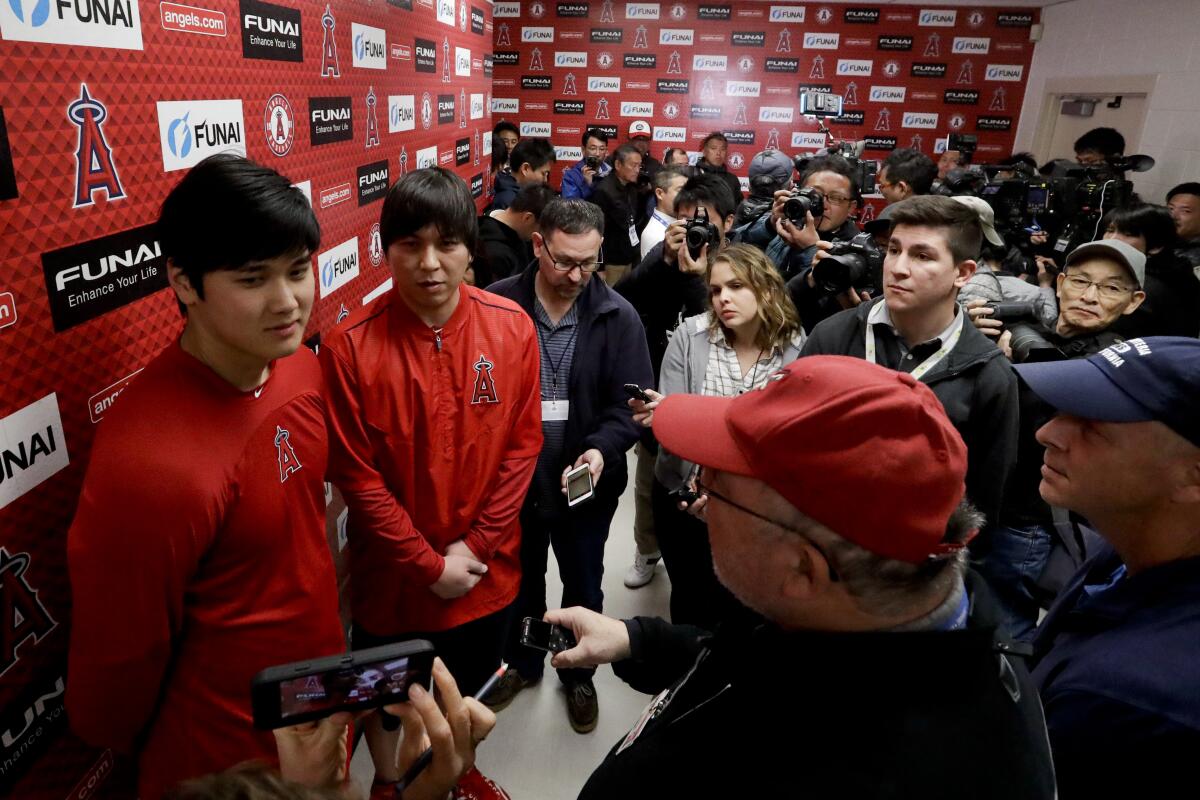
The writers that secure that kind of foundation become specialty writers the same way a baseball writer in the U.S. can be considered a team insider — except the specialty is knowledge of one player.
Yanagihara is that kind of writer. And his paper requires him to write a lot about Ohtani. Last year, he provided the majority of coverage for 53 newspaper front pages. Japanese sportswriting is typically short and to the point, so one story can be as little as a few sentences.
The day Ohtani hit for the cycle in June 2019, Yanagihara wrote three newspaper pages’ worth of stories.
“I wrote until 9 a.m. the next morning,” he said. “It was very crazy. And then I had to go to the stadium at 12 p.m. I had little time to sleep. Only three hours.”
Angels two-way star Shohei Ohtani was named starting pitcher for the team’s season opener against the Oakland Athletics on March 30.
This year, because of Ohtani’s participation in the World Baseball Classic with Japan, Yanagihara went back to Tokyo for a little extra time than usual. He also flew to Miami for the semifinals and then will go back to Tempe for the rest of spring training, when Ohtani and Samurai Japan are finished in the WBC. Wherever Ohtani goes is where Yanagihara will be.
“Of course it is a tough job for me,” Yanagihara said of being a baseball journalist. “I always miss my family. But it is my dream job.”
During the season, the group of Japanese writers and photographers snap photos and videos of Ohtani doing everything from his pregame routine to simply walking or joking around with his other teammates.
That also happens during spring training, though there are also broadcast news camera operators that hike up the hill that overlooks the Tempe facility, in order to record his car driving into the parking lot.
“What I was told is as a reporter covering baseball, you need to wait for them to come in and then wait until they get out,” explained Aoike of the cameras on the hill. Aoike is a columnist primarily for Tokyo Sports — but also a freelancer for other Japanese outlets — covering Ohtani.
“So you need to try to get footage of that to make sure that he arrives that day healthy. You never know, right? There could be some troubles on the road or maybe he’s late.”
It’s also a sign of respect and professionalism in Japanese culture, being at a stadium or facility as long as a player is.
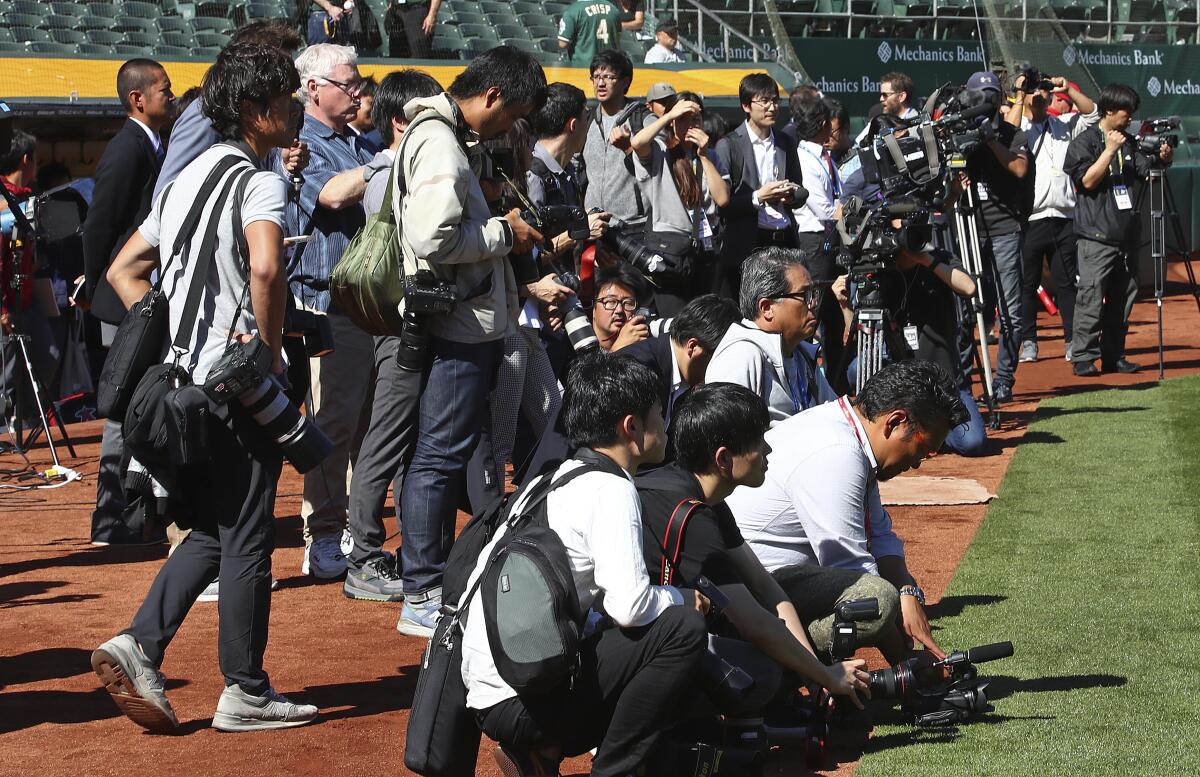
The scene is typical of every big Japanese star that’s come through MLB since Nomo in 1995.
“There’s a lot of media coming over, they didn’t know what the media rules were [here],” Grace McNamee said of her experience working in public relations for the Dodgers when Nomo came over. She presently works as a communications manager in the Angels public relations department, helping navigate the Japanese media that come to cover Ohtani.
“And it was an education process for all of us,” McNamee continued. “I had to create the media list to send it out to the various teams and to Major League Baseball. I translated some of the documents [from English to Japanese], like the clubhouse rules.”
The biggest difference from then to now, with Ohtani, McNamee explained, is the method of communication. For example, all the interview requests during Nomo’s time went through fax or snail mail, sometimes phone calls. Now, she can send a simple text message in a group chat to help relay information about interview times or schedules.
Much of the Japanese media covering Ohtani, like Abe and Aoike, have covered several other Japanese baseball stars before him. Aoike has lived in the U.S. since 2007, covering Hideki Matsui as a reporter for Nippon TV. Since Matsui, she also covered Suzuki when he was with the Yankees and Kenta Maeda, who spent four years with the Dodgers.
“Kenta was kind of like preparation for Shohei,” Aoike said. “When Shohei happened, all of a sudden it was all about Shohei and they asked me to go to [the stadium] every day.”
Aoike, since moving to the U.S., has gone back to Japan to visit family once or twice a year, mainly in January when the offseason is typically at its slowest. Her life is so ingrained here now though that even though her family is back in Japan, she feels more at home in the U.S. and driven by purpose covering Ohtani.
Shohei Ohtani strikes out five in his second WBC start, and also goes 1 for 4 with two runs scored in a 9-3 win to help Japan reach the WBC semifinals.
Her mother, who has since died, had pancreatic cancer in 2018, Ohtani’s first year with the Angels. When Aoike visited her in the hospital, she would see others there watching him on TV.
“I didn’t know how much Shohei meant to other people,” Aoike explained. “I have friends who aren’t baseball fans that watch him. It’s a feeling Shohei gives to people that makes me not obligated to, but I want to deliver the story to the people of Japan.”
Therein lies the difference, though. Why writers and photographers and videographers from Japan sacrifice so many of their lives just to cover Ohtani.
Honor.
“Before [Ohtani], it was just a job I tried to do my best at, now I want to tell the stories so that some people might feel good [reading about him] that day,” Aoike said.
Japan’s Shohei Ohtani hit his first home run at the World Baseball Classic vs. Australia on Sunday. The fan who caught the ball politely shared with the crowd.
- Share via
Watch L.A. Times Today at 7 p.m. on Spectrum News 1 on Channel 1 or live stream on the Spectrum News App. Palos Verdes Peninsula and Orange County viewers can watch on Cox Systems on channel 99.
More to Read
Go beyond the scoreboard
Get the latest on L.A.'s teams in the daily Sports Report newsletter.
You may occasionally receive promotional content from the Los Angeles Times.

